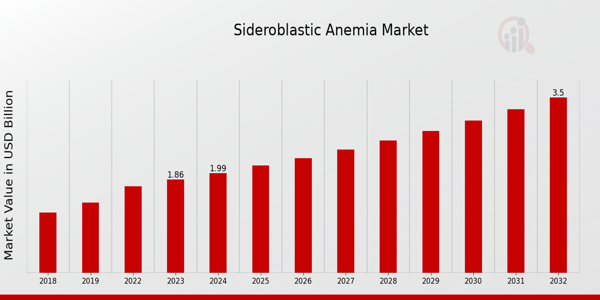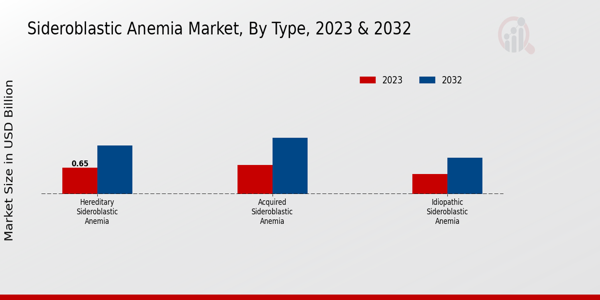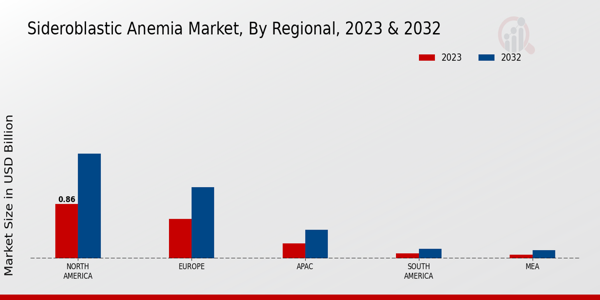Sideroblastic Anemia Market Overview
As per MRFR analysis, the Sideroblastic Anemia Market Size was estimated at 1.73 (USD Billion) in 2022. The Sideroblastic Anemia Market Industry is expected to grow from 1.86(USD Billion) in 2023 to 3.5 (USD Billion) by 2032. The Sideroblastic Anemia Market CAGR (growth rate) is expected to be around 7.3% during the forecast period (2024 - 2032).
Key Sideroblastic Anemia Market Trends Highlighted
The Sideroblastic Anemia Market is being significantly shaped by rising awareness of rare blood disorders and advancements in diagnostic techniques. Increased research initiatives and funding from both private and public sectors are creating a more favorable environment for the development of innovative therapies. Additionally, the growing emphasis on personalized medicine is driving the demand for targeted treatments, enabling healthcare providers to tailor interventions according to individual patient needs. These key market drivers contribute to a robust landscape for addressing sideroblastic anemia and optimizing patient outcomes.
Opportunities such as the integration of telemedicine and mobile health applications are gaining traction, allowing healthcare professionals to monitor and support patients remotely.This not only enhances patient engagement but also streamlines the management of sideroblastic anemia. Collaborations between pharmaceutical companies and research institutions offer avenues for the exploration of novel drug candidates and treatment methods. The global health crisis has also underscored the importance of resilient healthcare systems, which may lead to increased investment in areas related to blood disorders. Recent trends indicate a shift towards collaborative approaches, with stakeholders actively seeking partnerships to tackle challenges in diagnosis and treatment.
The rise of gene therapies and stem cell transplantation as potential treatment options is also noteworthy.Furthermore, educational initiatives aimed at healthcare providers and patients foster better understanding and management of this condition, promoting early diagnosis and intervention. Overall, the combination of these trends and opportunities is prompting a dynamic evolution within the Sideroblastic Anemia Market, steering it towards enhanced care and improved quality of life for affected individuals.

Source: Primary Research, Secondary Research, Market Research Future Database and Analyst Review
Sideroblastic Anemia Market Drivers
Increase in Prevalence of Sideroblastic Anemia
The rise in the global prevalence of sideroblastic anemia is one of the primary drivers contributing to the growth of the Sideroblastic Anemia Market Industry. As healthcare becomes more advanced, the accurate diagnosis of various blood disorders, including sideroblastic anemia, has improved significantly. Many patients who were previously undiagnosed or misdiagnosed are now being recognized and categorized correctly, leading to a surge in the number of reported cases. The condition's association with various genetic predispositions and environmental factors also plays a role as more individuals are tested and increasingly found to have the disorder.
With the growing awareness and education surrounding hematological issues, healthcare professionals are more likely to recognize symptoms and recommend detailed blood testing, which drives further diagnosis and subsequent treatment. This increasing awareness among clinicians and patients also pushes the demand for therapeutics and more specialized healthcare services directed at treating sideroblastic anemia, ultimately impacting the market growth positively. Additionally, evolving research and data in the field are prompting more laboratories and healthcare facilities to invest in state-of-the-art diagnostic equipment and advanced therapeutic modalities tailored for treating blood disorders, creating an overall supportive environment for market expansion.
As the population demographics shift, with an aging population in certain regions, the incidence rates may also increase, further fueling market growth.The need for innovative treatments and therapies to address the growing challenges associated with sideroblastic anemia will drive the expansion of this specific market, emphasizing the importance of focused research and development.
Advancements in Diagnostic Techniques
The substantial advancements in diagnostic techniques are crucial for the growth of the Sideroblastic Anemia Market Industry. Enhanced diagnostic methods, including genetic testing, molecular assays, and advanced imaging techniques, have enabled healthcare professionals to diagnose sideroblastic anemia more accurately and efficiently. As technologies evolve, the ability to detect sideroblastic anemia in its early stages has improved, leading to timely interventions that are vital for managing the condition.This technological progress not only aids in proper disease management but also encourages research into novel drugs and therapies aimed at this specific anemia type, further propelling market growth.
Growing Investment in R for Hemoglobin Disorders
The increase in investments directed toward research and development for hemoglobin disorders is becoming a significant driver for the Sideroblastic Anemia Market Industry. As pharmaceutical and biotechnology companies recognize the unmet medical needs of patients suffering from sideroblastic anemia, they are allocating more resources toward innovative treatment compounds and strategies.
By fostering collaborations with academic institutions and research organizations, these companies are accelerating the pace of discovering and developing advanced therapies, which may lead to more effective treatments for sideroblastic anemia.This trend not only enhances the treatment landscape but also opens avenues for new entrants into the market, further propelling market growth.
Sideroblastic Anemia Market Segment Insights
Sideroblastic Anemia Market Type Insights
The Sideroblastic Anemia Market, classified by Type, exhibits a diverse landscape characterized by significant segmentation, including Hereditary Sideroblastic Anemia, Acquired Sideroblastic Anemia, and Idiopathic Sideroblastic Anemia. In 2023, the market showcased an overall valuation of 1.86 billion USD, reflecting a keen interest in addressing this hematologic condition. Among these segments, Acquired Sideroblastic Anemia holds a prominent position with a valuation of 0.72 billion USD in 2023, indicating a strong prevalence linked to nutritional deficiencies and exposure to toxins.Its growth potential is driven by increasing recognition of environmental factors impacting hemoglobin production.
On the other hand, Hereditary Sideroblastic Anemia, valued at 0.65 billion USD, emerges as a crucial segment due to its genetic basis, emphasizing the need for genetic screening and family planning in affected households. This segment focuses on understanding hereditary patterns transmitted through bloodlines, which is vital for early diagnosis and treatment. Furthermore, Idiopathic Sideroblastic Anemia, though relatively smaller at a market valuation of 0.49 billion USD, is significant due to its unclear etiology, necessitating continued research into its underlying causes.
The Sideroblastic Anemia Market revenue is buoyed by advancements in diagnostic techniques and an increased emphasis on personalized treatment approaches across these types. With certain segments showing robust growth drivers, such as a growing aging population and the increasing prevalence of chronic diseases, the overall dynamics of the Sideroblastic Anemia Market segmentation reveal a complex interaction of demand for effective healthcare solutions, patient care improvements, and innovative therapeutic options tailored to specific types of sideroblastic anemia.

Source: Primary Research, Secondary Research, Market Research Future Database and Analyst Review
Sideroblastic Anemia Market Treatment Type Insights
The Sideroblastic Anemia Market is undergoing notable growth, particularly in the Treatment Type segment, which includes various approaches such as Iron Chelation Therapy, Vitamin B6 Therapy, Bone Marrow Transplant, and Supportive Care. The overall market value is positioned at 1.86 billion USD in 2023, demonstrating the rising demand for effective treatment options. Iron Chelation Therapy holds a major share as it effectively reduces iron overload, a common issue in sideroblastic anemia patients, making it a critical component of treatment. Vitamin B6 Therapy also plays a significant role in hemoglobin production, thus promoting overall health for affected individuals.
Bone Marrow Transplant represents a pivotal treatment option, particularly for severe cases, providing long-term solutions by addressing the underlying causes of the anemia. Supportive Care remains crucial, offering symptomatic relief and enhancing the quality of life for patients. These approaches contribute to the rising Sideroblastic Anemia Market revenue, driven by the increasing prevalence of the condition and ongoing advancements in treatment methodologies.As the market continues to evolve, advancements in treatment strategies and patient-centered care will further influence the Sideroblastic Anemia Market statistics and overall industry growth.
Sideroblastic Anemia Market Diagnosis Method Insights
The Sideroblastic Anemia Market, particularly within the Diagnosis Method segment, plays a crucial role in accurate identification and treatment planning. In 2023, the market will be valued at 1.86 billion USD, and key diagnostic techniques include blood tests, bone marrow biopsy, genetic testing, and imaging tests. Blood tests are vital, as they provide initial insights into hemoglobin levels and iron metabolism, making them a cornerstone for screening. Bone marrow biopsy holds significant importance as it allows for the evaluation of erythropoiesis and the detection of abnormal iron deposition in the marrow, facilitating diagnoses.
Genetic testing has gained prominence due to the increasing recognition of hereditary factors contributing to the condition, thus guiding targeted therapies. Imaging tests complement these diagnostics by visualizing potential structural anomalies and iron accumulation, thereby offering a comprehensive diagnostic approach. The interplay of these diagnostic methods underscores their collective significance, reflecting a dynamic landscape in Sideroblastic Anemia Market revenue.
Enhanced diagnostic accuracy and early intervention present substantial opportunities within the industry, ultimately driving the growth of the market amid evolving healthcare demands.Market growth in this segment is further supported by advancements in technology and rising awareness among healthcare professionals about effective diagnostic practices.
Sideroblastic Anemia Market End User Insights
The Sideroblastic Anemia Market encompasses various end users, particularly Hospitals, Diagnostic Laboratories, and Specialty Clinics. In 2023, the market was valued at 1.86 billion USD, reflecting the increasing demand for effective treatment and diagnostic services. Hospitals serve as a critical pillar in this market, providing essential care and advanced treatment protocols for patients suffering from sideroblastic anemia.
Diagnostic Laboratories play an instrumental role by offering detailed testing and analysis, aiding in accurate diagnosis and timely decision-making for patient care.Specialty Clinics focus on targeted treatment and management of blood disorders, catering to the specific needs of patients and driving personalized healthcare approaches. The growth drivers include the rising prevalence of blood disorders and advancements in diagnostic techniques. However, challenges such as high treatment costs and the need for specialized skills may impact the market. Nonetheless, continuous research and development present significant opportunities within this domain, allowing for improved therapeutic options and enhanced patient outcomes.
Sideroblastic Anemia Market Regional Insights
The Sideroblastic Anemia Market revenue is expected to reach 1.86 USD Billion in 2023, reflecting a diverse regional landscape. North America leads this space with a valuation of 0.86 USD Billion in 2023, a majority holding that signifies the region's advanced healthcare infrastructure and robust research activities. Europe follows, valued at 0.62 USD Billion, indicating its strong pharmaceutical sector and growing interest in hematological disorders.
The Asia-Pacific (APAC) market, though smaller at 0.24 USD Billion, is witnessing significant growth driven by increasing healthcare investments and rising awareness about rare diseases.South America and the Middle East Africa (MEA) hold valuations of 0.08 USD Billion and 0.06 USD Billion, respectively, suggestive of emerging opportunities, yet they currently represent the least dominant segments due to various market access challenges and lower healthcare expenditure. Overall, the market demonstrates promising growth prospects, shaped by evolving treatment strategies and a deeper focus on addressing unmet medical needs in regional healthcare systems.
The Sideroblastic Anemia Market Statistics highlight the importance of tailored therapies and innovative solutions that cater to specific regional demands, making it imperative for stakeholders to recognize and capitalize on these emerging trends.

Source: Primary Research, Secondary Research, Market Research Future Database and Analyst Review
Sideroblastic Anemia Market Key Players and Competitive Insights
The Sideroblastic Anemia Market is characterized by its dynamic nature, with a range of companies involved in developing innovative therapies and treatments. This market primarily focuses on addressing a rare blood disorder that affects the body’s ability to produce healthy red blood cells. With a growing awareness of the condition and an increase in research investment, key market players are striving to enhance their product offerings.
Competitive insights reveal that companies are not only working towards drug development but are also expanding their clinical trials, seeking to understand the underlying pathophysiology of sideroblastic anemia, which may lead to improved treatment protocols. The landscape is framed by efforts in technological advancements and strategic partnerships, which are crucial for gaining competitive advantage and ensuring regulatory compliance in a market that necessitates high levels of expertise and understanding of complex biological mechanisms.Pfizer has established a significant presence in the Sideroblastic Anemia Market, leveraging its robust research and development capabilities.
The company’s strengths lie in its extensive portfolio of hematology-focused therapies, allowing it to efficiently address the medical needs of patients suffering from this condition. Pfizer's established relationships with healthcare providers help promote clinical awareness and facilitate improved diagnosis, which is essential in the management of sideroblastic anemia. Moreover, the company’s commitment to innovation is reflected in its ongoing clinical trials, aimed at exploring novel therapeutic targets and advancing treatment options.
With a strong emphasis on patient-centric solutions, Pfizer is positioned to enhance the quality of care and outcomes for those affected by this disorder, contributing to its competitive edge in the market.Amgen also plays a pivotal role in the Sideroblastic Anemia Market, showcasing an impressive portfolio of biopharmaceutical products developed through rigorous research initiatives. The company is recognized for its biotechnological advancements, which significantly contribute to the ongoing efforts to better understand and treat sideroblastic anemia.
Amgen's strengths lie in its ability to leverage cutting-edge scientific research to create effective therapies that target various pathways in the development of red blood cells. The firm maintains strong collaboration with research institutions and healthcare providers, ensuring that it stays at the forefront of emerging trends and treatment modalities in the realm of hematological disorders. This proactive engagement with the medical community, coupled with its commitment to quality and innovation, positions Amgen as a formidable competitor in the Sideroblastic Anemia Market, dedicated to improving patient outcomes and advancing treatment paradigms.
Key Companies in the Sideroblastic Anemia Market Include
Sideroblastic Anemia Market Industry Developments
Recent developments in the Sideroblastic Anemia Market have seen increased activity among major pharmaceutical companies aimed at advancing treatment options for this rare blood disorder. Notable players such as Pfizer, Amgen, and Roche are actively pursuing the development of new therapies and clinical trials. In particular, Jazz Pharmaceuticals has announced promising outcomes related to its investigational products, contributing to a broader interest in this market segment. Current affairs indicate a growing focus on personalized medicine approaches from companies like AstraZeneca and Novartis, positioning themselves to address specific patient needs.
Additionally, the market is witnessing strategic movements, with reports on mergers and acquisitions, particularly concerning Hematologic Technologies and Boehringer Ingelheim, which could enhance their capabilities in research and drug development. The increasing emphasis on innovation in treatment regimens is also positively impacting market valuations, with several firms experiencing notable growth, thereby fostering a competitive landscape. These developments are expected to pave the way for improved patient outcomes and heightened investment in research for treatments targeting sideroblastic anemia, attracting interest from stakeholders across the healthcare spectrum.
Sideroblastic Anemia Market Segmentation Insights
Sideroblastic Anemia Market Type Outlook
- Hereditary Sideroblastic Anemia
- Acquired Sideroblastic Anemia
- Idiopathic Sideroblastic Anemia
Sideroblastic Anemia Market Treatment Type Outlook
Sideroblastic Anemia Market Diagnosis Method Outlook
Sideroblastic Anemia Market End User Outlook
Sideroblastic Anemia Market Regional Outlook
| Report Attribute/Metric |
Details |
| Market Size 2023 |
USD 116.07 billion |
| Market Size 2024 |
USD 119.06 billion |
| Market Size 2032 |
USD 162.48 billion |
| Compound Annual Growth Rate (CAGR) |
3.86% (2024-2032) |
| Base Year |
2023 |
| Market Forecast Period |
2024-2032 |
| Historical Data |
2018 & 2020 |
| Market Forecast Units |
Value (USD Billion) |
| Report Coverage |
Revenue Forecast, Market Competitive Landscape, Growth Factors, and Trends |
| Segments Covered |
Material, Type, Application, and Region |
| Geographies Covered |
North America, Europe, Asia-Pacific, and the Rest of the World |
| Countries Covered |
The U.S, Canada, Germany, France, the UK, Italy, Spain, China, Japan, India, Australia, South Korea, and Brazil |
| Key Companies Profiled |
Ball Corporation, Crown Holdings Inc, Can pack SA, Silgan Holdings Incorporated, Tubex GmbH, Grief Incorporated, Mauser Packaging Solutions, Ardagh Group, DS Containers Inc, and CCL Containers Inc |
| Key Market Opportunities |
High-quality products and cost-effectiveness |
| Key Market Dynamics |
Increasing consumption of beverages Demand for aerosol cans |
Frequently Asked Questions (FAQ):
The Sideroblastic Anemia Market is expected to reach a value of 3.5 USD Billion by 2032.
The anticipated CAGR for the Sideroblastic Anemia Market from 2024 to 2032 is 7.3%.
North America is projected to have the largest market share in the Sideroblastic Anemia Market, valued at 1.65 USD Billion by 2032.
Europe is expected to reach a market size of 1.12 USD Billion in the Sideroblastic Anemia Market by 2032.
The market size for Acquired Sideroblastic Anemia is projected to be 1.4 USD Billion by 2032.
Key players in the Sideroblastic Anemia Market include Pfizer, Amgen, Eisai, and Bristol Myers Squibb.
The APAC region is anticipated to grow at a rate reaching a market size of 0.45 USD Billion by 2032.
The expected market size for Hereditary Sideroblastic Anemia is projected to be 1.2 USD Billion by 2032.
The Sideroblastic Anemia Market is facing challenges related to treatment accessibility and awareness.
The estimated market size for Sideroblastic Anemia in South America is expected to be 0.15 USD Billion by 2032.

















